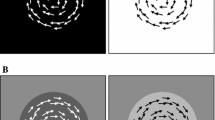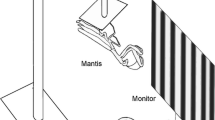Summary
Action potentials evoked by stepwise-moving visual stimuli have been recorded extracellularly from the horizontally selective movement detectors in the lobula complex of the blowflyCalliphora erythrocephala (M.).
Regarding the relation between the ommatidial mosaic structure of the compound eye and the behaviour of the detector, the following experimental results are obtained:
-
a)
Maximum reactions are obtained for stimuli which move with a stepwidth equal toδϕ h, whereδϕ h is the effective interommatidial angle.
-
b)
When using stepwise moving single contrast borders the reaction to a moving Dark over Bright contrast border is always greater than or equal to the reaction evoked by a moving Bright over Dark contrast border.
-
c)
From experiments with spatially small stimuli in which only a few rows of adjoining ommatidia are stimulated, the conclusion is drawn that the sensitivity distribution of the detector is spatially modulated with a period which equals the interommatidial angleδϕ.
-
d)
If the spatial wavelengthλ s of a square wave grating is adjusted in such a way thatδϕ h<λ s<2δϕ h, the reaction of the detector is reversed: movement in the preferred direction results in inhibition and movement in the null direction results in excitation.
Similar content being viewed by others
References
Beersma, D.G.M., Stavenga, D.G., Kuiper, J.W.: Organization of visual axis in the compound eye of the flyMusca domestica L. and behavioural consequences. J. comp. Physiol.102, 305–320 (1975)
Braitenberg, V.: Patterns of projection in the visual system of the fly. I. Retina-lamina projections. Exp. Brain Res.3, 271–298 (1967)
Braitenberg, V.: Ordnung und Orientierung der Elemente im Sehsystem der Fliege. Kybernetik7, 235–242 (1970)
Braitenberg, V.: Periodic structures and structural gradients in the visual ganglia of the fly. In: Information processing in the visual systems of arthropods (ed. R. Wehner), pp. 3–15. Berlin-Heidelberg-New York: Springer 1972
Buchner, E.: Elementary movement detectors in an insect visual system. Biol. Cybernetics24, 85–101 (1976)
Geiger, G.: Optomotor responses of the flyMusca domestica to transient stimuli of edges and stripes. Kybernetik16, 37–43 (1974)
Götz, K.G.: Optomotorische Untersuchung des visuellen Systems einiger Augenmutanten der FruchtfliegeDrosophila. Kybernetik2, 77–92 (1964)
Götz, K.G., Wenking, H.: Visual control of locomotion in the walking fruitflyDrosophila. J. comp. Physiol.85, 235–266 (1973)
Hassenstein, B.: über die Wahrnehmung der Bewegung von Figuren und unregelmä\igen Helligkeitsmustern. Z. vergl. Physiol.40, 556–592 (1958)
Kirschfeld, K.: The visual system ofMusca: Studies on optics, structure and function. In: Information processing in the visual systems of arthropods (ed. R. Wehner), pp. 61–74. Berlin-Heidelberg-New York: Springer 1972
Mastebroek, H.A.K.: Stochastic structure of neural activity in the visual system of the blowfly. Thesis, Groningen 1974
Mastebroek, H.A.K., Zaagman, W.H., Kuiper, J.W.: Intensity and structure of visually evoked neural activity: rivals in modelling a visual system. Vision Res.17, 29–35 (1977)
McCann, G.D., Arnett, D.W.: Spectral and polarization sensitivity of the dipteran visual system. J. gen. Physiol.59, 534–558 (1972)
Reichardt, W.: Autocorrelations-Auswertung als Funktionsprinzip des Zentralnervensystems (bei der optischen Bewegungswahrnehmung eines Insektes). Z. Naturforsch.12b, 448–457 (1957)
Reichardt, W., Varju, D.: übertragungseigenschaften im Auswertesystem für das Bewegungssehen. Z. Naturforsch.14b, 674–689 (1959)
Stavenga, D.G.: The neural superposition eye and its optical demands. J. comp. Physiol.102, 297–304 (1975)
Strausfeld, N.J.: The organization of the insect visual system (light microscopy). I. Projections and arrangements of neurons in the lamina ganglionaris of Diptera. Z. Zellforsch.121, 377–441 (1971)
Trujillo-Cenóz, O.: The structural organization of the compound eye in insects. In: Handbook of sensory physiology, Vol. VII/2 (ed. M.G. Fuortes), pp. 5–62. Berlin-Heidelberg-New York: Springer 1972
Author information
Authors and Affiliations
Additional information
We thank all our colleagues of the Department of Biophysics. Discussions with Mr. D.G.M. Beersma markedly improved the presentation of the results. We are indebted to Mr. B. Pijpker and Mr. E. Nienhuis for technical help. Miss H.E. Deenen carefully typed the manuscript, Mr. B. Kamps drew the figures.
Through the foundation “Stichting voor Biofysica” this research was supported by the “ Netherlands Organization for the Advancement of Pure Research” (Z.W.O.).
Rights and permissions
About this article
Cite this article
Zaagman, W.H., Mastebroek, H.A.K., Buyse, T. et al. Receptive field characteristics of a directionally selective movement detector in the visual system of the blowfly. J. Comp. Physiol. 116, 39–50 (1977). https://doi.org/10.1007/BF00605515
Received:
Issue Date:
DOI: https://doi.org/10.1007/BF00605515




